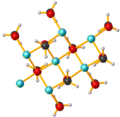anionic polymerization: An ionic polymerization in which the kinetic-chain carriers are anions. In polymer chemistry, anionic addition polymerization...
16 KB (1,844 words) - 07:30, 14 December 2024
In polymer chemistry, radical polymerization (RP) is a method of polymerization by which a polymer forms by the successive addition of a radical to building...
46 KB (5,475 words) - 22:45, 20 January 2025
growth polymerization include cationic addition polymerization and anionic addition polymerization. A special case of chain-growth polymerization leads...
14 KB (1,444 words) - 17:42, 10 February 2025
through polymerization of ethene. It can be produced through radical polymerization, anionic addition polymerization, ion coordination polymerization or cationic...
12 KB (1,552 words) - 04:59, 13 October 2024
Chain-growth polymerization (AE) or chain-growth polymerisation (BE) is a polymerization technique where monomer molecules add onto the active site on...
23 KB (2,680 words) - 04:08, 5 May 2025
polymer chemistry, ring-opening polymerization (ROP) is a form of chain-growth polymerization in which the terminus of a polymer chain attacks cyclic monomers...
21 KB (2,367 words) - 06:43, 18 February 2025
cationic polymerization: An ionic polymerization in which the kinetic-chain carriers are cations. In polymer chemistry, cationic polymerization is a type...
22 KB (2,638 words) - 11:12, 10 December 2024
In polymer chemistry, living polymerization is a form of chain growth polymerization where the ability of a growing polymer chain to terminate has been...
37 KB (4,445 words) - 05:32, 3 June 2024
Dispersity (category Polymer chemistry)
polymer. For bulk radical polymerization with low (<10%) conversion, anionic polymerization, and step growth polymerization to high conversion (>99%)...
14 KB (1,713 words) - 04:40, 19 April 2025
1.1.1-Propellane (section Polymerization)
oligomers. An anionic addition polymerization with n-butyllithium results in a fully polymerized product. X-ray diffraction of the polymer shows that the...
7 KB (738 words) - 14:11, 23 May 2024
Sodium polyacrylate (redirect from Acrylic Sodium Salt Polymer)
Inverse emulsion polymerization requires water, monomers, and a surfactant. Also, inverse emulsion polymerization is used to polymerize hydrophilic monomers...
33 KB (3,784 words) - 12:40, 20 January 2025
type of polymerization. The masking can be removed after polymerization so that they regain their pH-sensitive functionality. Living polymerization is often...
11 KB (1,392 words) - 00:24, 27 March 2023
alternative to radical polymerization, and may refer to anionic polymerization or cationic polymerization. As with radical polymerization, reactions are initiated...
7 KB (791 words) - 20:50, 21 October 2023
Reactive center (category Polymer chemistry)
chain-growth polymer chemistry, this is also the point of propagation for a growing chain. The reactive center is commonly radical, anionic, or cationic...
834 bytes (82 words) - 17:43, 17 December 2023
transfer polymerization, transition metal catalysis, living anionic polymerization, living cationic polymerization, ring opening polymerization, ring-opening...
19 KB (2,165 words) - 04:45, 27 December 2024
Poly(methacrylic acid) (redirect from PMAA (polymer))
a challenge with, for example, anionic polymerization, group transfer polymerization (GTP, see living polymerization) and ATRP. The latter is not currently...
9 KB (997 words) - 13:35, 3 November 2024
Styrene-butadiene (redirect from Styrene/butadiene co-polymer)
additives can be removed from the polymer. Solution-SBR is produced by an anionic polymerization process. Polymerization is initiated by alkyl lithium compounds...
11 KB (1,006 words) - 15:07, 5 February 2025
Copolymer (redirect from Alternating polymer)
metathesis polymerization (ROMP), and living cationic or living anionic polymerizations. An emerging technique is chain shuttling polymerization. The synthesis...
37 KB (4,267 words) - 18:01, 27 April 2024
Polyacrylic acid (category Acrylate polymers)
like any acrylate polymer, is usually synthesized through a process known as free radical polymerization, though graft polymerization may also be used...
20 KB (1,784 words) - 17:06, 7 April 2025
methyl ethers. Sodium methoxide is used as an initiator of anionic addition polymerization with ethylene oxide, forming a polyether with high molecular...
9 KB (697 words) - 15:57, 6 March 2025
In polymer chemistry, emulsion polymerization is a type of radical polymerization that usually starts with an emulsion incorporating water, monomers, and...
25 KB (3,401 words) - 04:29, 15 March 2025
added to lower interfacial tension and stabilize polymer particles to prevent demulsification. Anionic surfactants such as sodium dodecyl sulfate are most...
15 KB (1,912 words) - 15:25, 19 December 2024
polymerisation is a form of polymerization that is catalyzed by transition metal salts and complexes. Coordination polymerization started in the 1950s with...
8 KB (858 words) - 16:55, 3 May 2023
radical polymerization known as reversibly addition-fragmentation chain transfer (RAFT) mediated polymerization. RAFT-mediated polymerization of PTMA...
17 KB (2,078 words) - 13:18, 31 August 2023
functional resins can be homo-polymerized with anionic or cationic catalysts and heat, or copolymerised through nucleophilic addition reactions with multifunctional...
14 KB (1,744 words) - 15:41, 15 January 2025
Polystyrene (category Organic polymers)
co-polymerization, SBC by anionic block co-polymerization, which makes it transparent in case of appropriate block size. If styrene-butane co-polymer has...
82 KB (8,635 words) - 23:17, 19 April 2025
a white powder when pure. It is used as an initiator of an anionic addition polymerization with ethylene oxide, forming a polyether with high molecular...
10 KB (1,008 words) - 21:11, 11 December 2024
Α-Olefin sulfonate (category Anionic surfactants)
content. In addition to a longer hydrocarbon chain in which there must be at least one double bond (hence the name "olefin"), it has an anionic sulfonate...
5 KB (548 words) - 13:35, 15 October 2024
Polyethylene glycol (category Polymers)
Depending on the catalyst type, the mechanism of polymerization can be cationic or anionic. The anionic mechanism is preferable because it allows one to...
39 KB (4,161 words) - 23:36, 17 April 2025
lower pKa than styrene, it is an effective mediator in the anionic living polymerization of styrene-block-methyl methacrylate copolymers. Polystyrene...
3 KB (310 words) - 18:36, 8 April 2025
















